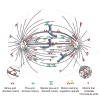How kinesin motor proteins drive mitotic spindle function: Lessons from molecular assays
- PMID: 20109570
- PMCID: PMC2844474
- DOI: 10.1016/j.semcdb.2010.01.018
How kinesin motor proteins drive mitotic spindle function: Lessons from molecular assays
Abstract
Kinesins are enzymes that use the energy of ATP to perform mechanical work. There are approximately 14 families of kinesins within the kinesin superfamily. Family classification is derived primarily from alignments of the sequences of the core motor domain. For this reason, the enzymatic behavior and motility of each motor generally reflects its family. At the cellular level, kinesin motors perform a variety of functions during cell division and within the mitotic spindle to ensure that chromosomes are segregated with the highest fidelity possible. The cellular functions of these motors are intimately related to their mechanical and enzymatic properties at the single molecule level. For this reason, motility studies designed to evaluate the activity of purified molecular motors are a requirement in order to understand, mechanistically, how these motors make the mitotic spindle work and what can cause the spindle to fail. This review will focus on a selection of illustrative kinesins, which have been studied at the molecular level in order to inform our understanding of their function in cells. In addition, the review will endeavor to point out some kinesins that have been studied extensively but which still lack sufficient molecular underpinnings to fully predict their contribution to spindle function.
Copyright 2010 Elsevier Ltd. All rights reserved.
Figures


Similar articles
-
Kinesin-8 molecular motors: putting the brakes on chromosome oscillations.Trends Cell Biol. 2008 Jul;18(7):307-10. doi: 10.1016/j.tcb.2008.05.003. Epub 2008 May 29. Trends Cell Biol. 2008. PMID: 18513970 Free PMC article. Review.
-
Mitotic functions of kinesin-5.Semin Cell Dev Biol. 2010 May;21(3):255-9. doi: 10.1016/j.semcdb.2010.01.019. Epub 2010 Jan 28. Semin Cell Dev Biol. 2010. PMID: 20109572 Free PMC article. Review.
-
Mechanisms by Which Kinesin-5 Motors Perform Their Multiple Intracellular Functions.Int J Mol Sci. 2021 Jun 15;22(12):6420. doi: 10.3390/ijms22126420. Int J Mol Sci. 2021. PMID: 34203964 Free PMC article. Review.
-
Bidirectional motility of kinesin-5 motor proteins: structural determinants, cumulative functions and physiological roles.Cell Mol Life Sci. 2018 May;75(10):1757-1771. doi: 10.1007/s00018-018-2754-7. Epub 2018 Feb 3. Cell Mol Life Sci. 2018. PMID: 29397398 Free PMC article. Review.
-
The Arabidopsis thaliana Kinesin-5 AtKRP125b Is a Processive, Microtubule-Sliding Motor Protein with Putative Plant-Specific Functions.Int J Mol Sci. 2021 Oct 21;22(21):11361. doi: 10.3390/ijms222111361. Int J Mol Sci. 2021. PMID: 34768803 Free PMC article.
Cited by
-
KIF15 contributes to cell proliferation and migration in breast cancer.Hum Cell. 2020 Oct;33(4):1218-1228. doi: 10.1007/s13577-020-00392-0. Epub 2020 Jun 23. Hum Cell. 2020. PMID: 32578050
-
Integrated bioinformatics analysis of potential biomarkers for pancreatic cancer.J Clin Lab Anal. 2022 May;36(5):e24381. doi: 10.1002/jcla.24381. Epub 2022 Apr 11. J Clin Lab Anal. 2022. PMID: 35403252 Free PMC article.
-
Kinesin family member 4A: a potential predictor for progression of human oral cancer.PLoS One. 2013 Dec 30;8(12):e85951. doi: 10.1371/journal.pone.0085951. eCollection 2013. PLoS One. 2013. PMID: 24386490 Free PMC article. Clinical Trial.
-
Recent advances in understanding oogenesis: interactions with the cytoskeleton, microtubule organization, and meiotic spindle assembly in oocytes.F1000Res. 2018 Apr 17;7:F1000 Faculty Rev-468. doi: 10.12688/f1000research.13837.1. eCollection 2018. F1000Res. 2018. PMID: 29755732 Free PMC article. Review.
-
Gene expression of cytokinesis regulators PRC1, KIF14 and CIT has no prognostic role in colorectal and pancreatic cancer.Oncol Lett. 2021 Aug;22(2):598. doi: 10.3892/ol.2021.12859. Epub 2021 Jun 9. Oncol Lett. 2021. PMID: 34188700 Free PMC article.
References
-
- Kuhne W. Untersuchungen fiber das Protoplasma und die Contractilitat. Leipzig: von Wilhelm Engelmann; 1864.
-
- Engelhardt WA, Ljubimowa MN. Myosine and adenosinetriphosphatase. Nature. 1939;144:668–69.
-
- Mottier DM. The behavior of the chromosomes in the spore mother-cells of higher plants and the homology of the pollen and embryo-sac mother cells. Bot Gazette. 1903;35:250–85.
-
- Gibbons IR, Rowe AJ. Dynein: A Protein with Adenosine Triphosphatase Activity from Cilia. Science (New York, NY) 1965 Jul 23;149(3682):424–6. - PubMed
Publication types
MeSH terms
Substances
Grants and funding
LinkOut - more resources
Full Text Sources

